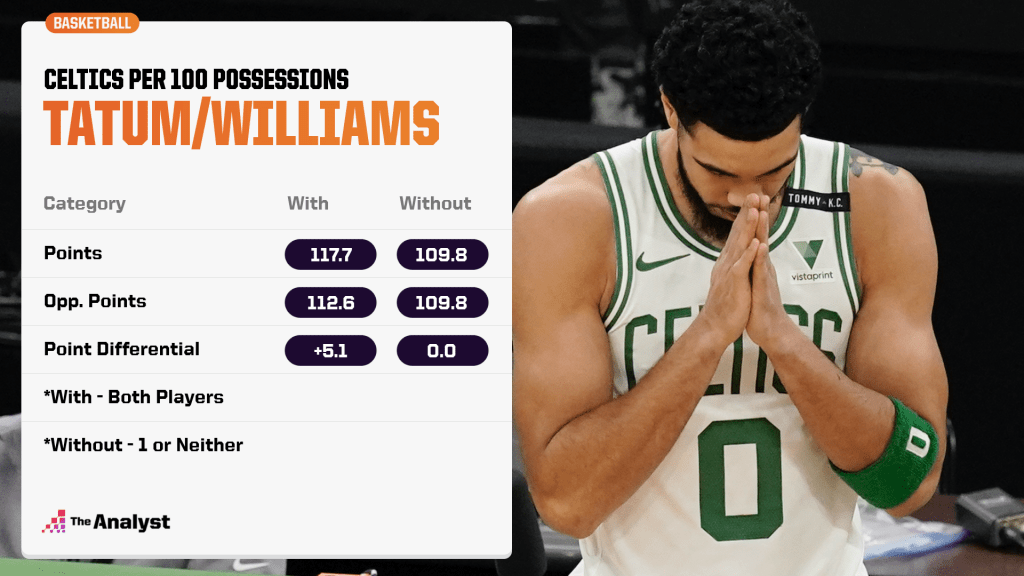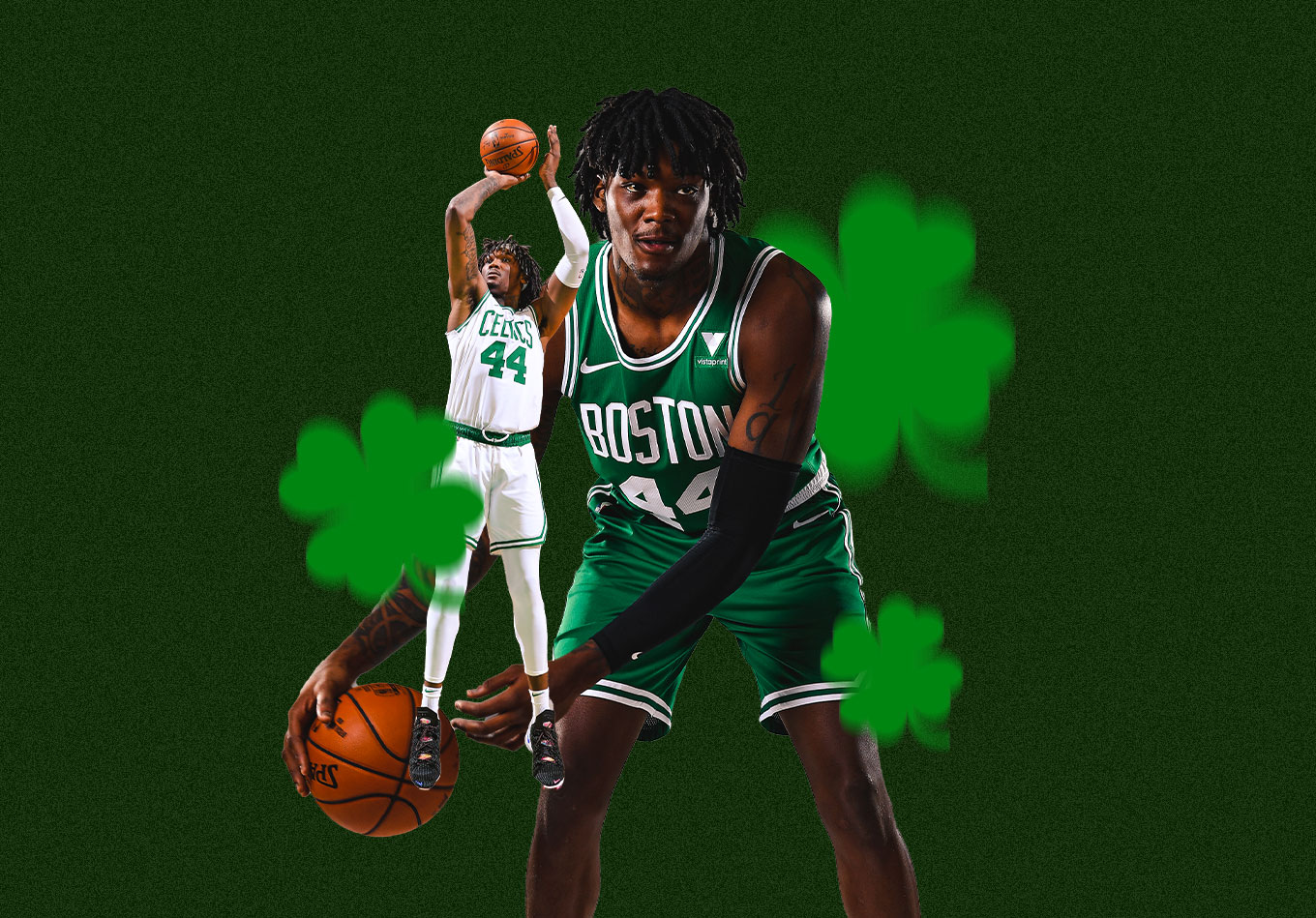Late in the shot clock, Robert Williams III finds himself isolated on the perimeter against Jordan Clarkson, who wiggles toward the basket.
He stops short, avoiding Marcus Smart’s help defense at the rim. Amid the deceleration, he tosses a subtle shot fake toward the hoop. Williams bites and leaves his feet. Yet before Clarkson can cleanly parlay that guile into a floater, Williams pogo-sticks back into the air, darts up his hands and grazes his fingertips across the ball for a block.
For most guys, that initial decision would be a death knell. Williams is, well, different. His athletic assets enhance his margin of error and afford him distinguished recovery time. He reacts with a second jump long after Clarkson has left the ground, and it doesn’t matter because he’s that bouncy and lively off the floor.
This sequence, in many regards, embodies The Robert Williams Experience. He is mistake-prone and undisciplined, albeit tantalizingly gifted, often rendering those gaps in his portfolio irrelevant to forge a positive impact by achieving plays considered far-fetched for many.
Keeping Williams engaged, emboldening him to play hyperactive defense, is the path to maximizing his 7-foot-6 wingspan, sprightly vertical and penchant for event creation. His 8.7% block rate is right up there with Nerlens Noel behind Myles Turner, and his 2.1% steal rate is just behind Marcus Smart for the team lead, kindling chaos and turning teams over unlike the majority of his long-limbed peers.
As a pick-and-roll big, Williams is at his best operating near the level of the screen, hedging or trapping. Each gambit is designed to leverage his size, playmaking instincts and mobility to overwhelm ball-handlers. He’s dexterous pick-pocketing opponents on drives and maintains active hands, muddying angles for passes to rollers.
With his length and leaping ability, stationing him near the 3-point arc – or wherever the action commences – deters guys from trying to launch over his reach, and he’s fleet-footed enough to contain them downhill as well.
It’s not solely in pick-and-rolls where he pressures offenses and authors plays few others could replicate. He frequents passing lanes for swipe-and-slams. Tied for fourth in blocked 3-pointers this season, he alters shots on the perimeter, possessing the tools to sag off and dissuade a drive while still affecting the outcome of a potential jumper.
Despite a proclivity for turning the opposition over, Williams does not (yet) regularly complement that with sound, unglamorous services. Issues commonly arise when he is deployed in conservative schemes, particularly standard drop coverage.
While his hands are a boon in passing lanes and aggressive coverages, his primary instinct is to flare them out when someone approaches him downhill, leading to fouls. He’s trimmed his fouls per 100 possessions down from 6.3 during his first two seasons to 5.2 this year but remains prone to incurring unnecessary fouls because of poor technique. Training himself to use his body rather than his hands in these instances is paramount.
Similarly, he is overly jumpy as a shot-blocker, compromising rotations or defensive integrity, whether it be scoring avenues or offensive rebounding chances, in pursuit of ill-advised gambles. Counters, hesitations, pump-fakes and anything that isn’t a direct move to score can cause him to abandon proper positioning.
This is the dichotomy of Williams’ defensive value. Reining him in is challenging because his event creation is legitimately useful, increasing Boston’s fast-break success and volume when he’s on the floor, according to Cleaning The Glass. Transition offense is more efficient than half-court contexts, so Williams’ impact is rather notable. But he isn’t a versatile ball-screen defender, and savvy scorers brandish the trickery to deceive him.
He’s tailored for an aggressive philosophy, and as he continues to develop, perhaps he becomes truly elite in it (he doesn’t turn 24 until the start of next season!). For now, he is good in a somewhat novel scheme, which is hard to employ for long stretches because of the strain it puts on back-line help and the ways Williams is susceptible to breakdowns against premier initiators.
His block rate and highlight-reel swats overstate his rim protection prowess, too. Although he’s capable of closing down improbable chunks of space in rotations to prevent baskets – and is a serviceable rim protector – he doesn’t pair those sequences with enough possession-by-possession consistency, hindered by technique and awareness shortcomings.
Face-guarding Enes Kanter, despite his offensive rebounding mastery, is not the job of a defensive anchor and conveys a concerning degree of understanding of his responsibility in that spot. Immediately fouling Kanter after executing a timely tag is imprudent decision-making. Waiting until Bradley Beal has exploded past Payton Pritchard before rotating is delayed processing. Preeminent rim protectors interpret events and act promptly and sharply.
Williams has played twice as many minutes this season as he did his first two years combined, so the emphasis should be to smooth out these edges with more reps and film study. He has the athleticism and physical characteristics to impose himself at the rim, but much more is required to genuinely enforce the interior with a significant minutes load.
Currently, he is a platoon center who needs technical refinement for optimal pick-and-roll and rim protection utility. He struggles with weak-side awareness. When defensive structure wilts and Williams must clean up any mess, that is an overextension of his contemporary abilities. Learning to excel in those situations is difficult, but nonetheless imperative as he seeks to make the leap from worthwhile rotation big to high-level starter who fortifies the defense.
Whereas the Celtics likely demand him to be the tip of the spear defensively, he already slots in comfortably as an ancillary player offensively. A supreme play finisher with an elite catch radius, he is shooting 76% at the rim, which is up almost 2% from the past two seasons and offering Boston ball-handlers a reliable release valve inside. Basically, just loft the ball around his orbit and he’ll corral it, fueled by synchronized body coordination, his 7-foot-6 wingspan and an effortless vertical. Few defenders can mirror those genes, and the results are evident.
That last clip is bonkers – jumping, catching, spinning and finishing in one motion.
On a team whose center rotation this season has yearned for any sort of offensive dynamicity, Williams brings that, both as a lob threat and tertiary facilitator. His playmaking, particularly threading dimes or rifling bullets to cutters, draws opposing bigs away from the basket and clears the lane to, ideally, help manufacture rim pressure for a squad that lacks it.
Most importantly, though, is how Williams’ emergence has conceivably benefitted the Celtics’ wing tandem of Jayson Tatum and Jaylen Brown, whose career-best season is over because of a wrist injury. But both players, especially Tatum, have been tasked with heavy creation burdens, unaccustomed to playing alongside a big man who can ease the tension for them (miss you, Al Horford). Williams, in some capacity, does that.
Over the past few months, Boston has increased how often it tries to scheme buckets for Tatum, slotting him off the ball and applying his size for easier, quicker shots. Williams is a vehicle for that with his passing.

If teams trap Tatum, intending to mitigate his pull-up shooting and coax the Celtics to allocate offense elsewhere, the third-year center has the chops for exploiting 4-on-3 advantages. Because limiting his time of possession and dribbling opportunities is key, Williams is not Draymond Green on the short roll. But he is sufficient in brief spurts, which is crucial while Tatum cements himself as a pull-up maestro who lures traps well beyond the arc.
When those two play together this season, the Celtics have a plus-5.1 point differential per 100 possessions, bolstered by 117.7 points per 100. Tatum sharing minutes with someone who invites diversified creation for him is a welcomed addition. It’s not just isolations, high screen-and-rolls or the occasional mid-post touch anymore. He’s more scalable than his conventional usage suggests, and Williams helps showcase that.
There are also flashes of dribble hand-off craft, where Williams is manipulative in his delivery and flips the angles of picks to enact separation on the perimeter. Because he is typically a poor screener, either failing to make adequate contact or committing conspicuous offensive fouls, entrusting him as a DHO trigger man is probably overzealous at this juncture.
A small foundation exists, though, and is a strategy to expand his offensive equity, especially if he blossoms as a decision-maker and proves worthy of more complex duties on this end (though, that remains a big “if”).
Injuries, bouts of COVID, poor wing and bench depth, disappointing losses and uninspiring offensive sets have melded for a comparatively crummy 2020-21 Celtics season. Outside of Tatum and Brown’s sustained offensive burgeoning, Williams’ evolution from a sporadically talented young dude to a viable rotation big is the glimmer of hope from this year.
Offensively, he’s exhibited a baseline to function concordantly with Tatum, the franchise pillar. He holsters efficacy alongside many guys via his distributing and dominant play finishing. The defense, however, is more shine than substance (right now).
His defensive playmaking carries gravity, but he needs to more appropriately balance his eagerness and frugality while learning how to accurately handle conservative coverages and help-side rotations. Skepticism in him accomplishing those intricate improvements is warranted, but he’s young enough that incremental growth as he enters his prime in the next few years is a justified belief. Either way, the offensive package is multifaceted and enticing, and the driving force behind his rise and long-term allure.
Williams is a good NBA player who aids the Celtics in a concentrated role. He routinely performs astounding sequences like these (or others included above). Now, the looming hurdle of progressing beyond “good” exists.
He must further redefine The Robert Williams Experience, one that could feature vital defensive maturation to become both discretionary and terrorizing, and an exceptionally practical offensive big man.
Research support by Josiah Sukumaran. Design by Matt Sisneros.
Enjoy this? Subscribe to our newsletter to have top stories sent directly to your inbox each week. It’s free!
